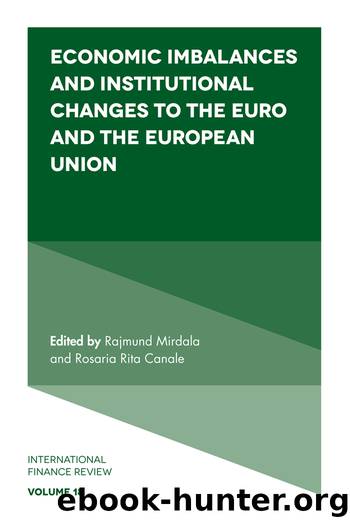Economic Imbalances and Institutional Changes to the Euro and the European Union by Mirdala Rajmund;Canale Rosaria Rita;

Author:Mirdala, Rajmund;Canale, Rosaria Rita;
Language: eng
Format: epub
Publisher: Emerald Publishing Limited
Published: 2017-08-01T00:00:00+00:00
THE THEORY OF OPTIMAL CURRENCY AREA-BASED BU
Mundell (1961) argued that in the case of asymmetric shocks and structural rigidities in the labor market exchange rate could be an important tool to restore economic balance. McKinnon (1963) argues that if one country is more open to the world, there is a lower usefulness of flexible exchange rate. Mundell (1961) argued that, in case of asymmetric shocks and structural rigidities in a labor market, the exchange rate could be an important tool to restore economic equilibrium. Mundell (1968, p. 177) says that âthe single currency imply a single central bankâ and easier âadjustment inside the currency area, which has a single currency and currency space.â He defines an optimal currency zone âas an area of internal mobility of factors (including among-regional and inter-industrial mobility) and external factor immobilization.â Kawai (1987) relying on the Mundell theory emphasized that if countries are highly integrated into the financial trading then capital flows can smooth episodic asymmetric shocks.
In the nineties of the last century, many economists have used the Mundell theory as a tool to explain whether a country should or should not join the monetary union. This approach is contrary to the original intention of the Mundell (1998, p. A22) and the theory of the inconsistent quartet formulated by Padoa-Schioppa (1987). The main argument that has emerged from these debates is that the flexibility of factor markets (capital and labor) could be the key criteria for an explanation of optimum currency areas. Flexibility should pertain to two aspects: across-the-board mobility and flexible prices (Geeroms & Karbownik, 2014, p. 7). Many economists criticized this argument stating that labor mobility is higher in the United States than in Europe and that Europe could be the optimum currency area (Eichengreen, 1991).
The mobility of labor is close to zero between North and South, and at a very low level between the West and the East of the EU (Geeroms & Karbownik, 2014, p. 7). The annual mobility within the 15 EU countries and between regions shows an annual average rate of 1% and cross-border mobility of 0.35%.
Both mobility with and between countries in the EU is well below the rate in Australia (1.5%) and the United States (2.4%), although rates are similar to those of the Canadian provinces (OECD, 2012, p. 64; Fig. 1).
Download
This site does not store any files on its server. We only index and link to content provided by other sites. Please contact the content providers to delete copyright contents if any and email us, we'll remove relevant links or contents immediately.
The Brazilian Economy since the Great Financial Crisis of 20072008 by Philip Arestis Carolina Troncoso Baltar & Daniela Magalhães Prates(121602)
International Integration of the Brazilian Economy by Elias C. Grivoyannis(91523)
The Art of Coaching by Elena Aguilar(52951)
Flexible Working by Dale Gemma;(23254)
How to Stop Living Paycheck to Paycheck by Avery Breyer(19638)
The Acquirer's Multiple: How the Billionaire Contrarians of Deep Value Beat the Market by Tobias Carlisle(12242)
Thinking, Fast and Slow by Kahneman Daniel(12080)
The Radium Girls by Kate Moore(11927)
The Art of Thinking Clearly by Rolf Dobelli(10229)
Hit Refresh by Satya Nadella(9040)
The Compound Effect by Darren Hardy(8815)
Tools of Titans by Timothy Ferriss(8222)
Atomic Habits: Tiny Changes, Remarkable Results by James Clear(8188)
Turbulence by E. J. Noyes(7941)
A Court of Wings and Ruin by Sarah J. Maas(7653)
Change Your Questions, Change Your Life by Marilee Adams(7637)
Nudge - Improving Decisions about Health, Wealth, and Happiness by Thaler Sunstein(7622)
How to Be a Bawse: A Guide to Conquering Life by Lilly Singh(7394)
Win Bigly by Scott Adams(7095)
